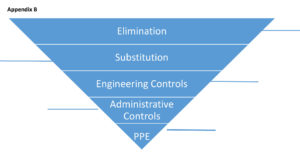- This Discussion Thread has 0 replies, 1 voice, and was last updated 1 year, 8 months ago by John-paul.
Viewing 0 reply threads
-
AuthorPosts
-
-
2024-04-12 at 4:23 pm #12379John-paulKeymaster
Reflection activity: Thinking of your current or a past workplace provide specific examples of each hierarchy of control – see Appendix B.

-
-
AuthorPosts
Viewing 0 reply threads
- You must be logged in to reply to this Discussion Thread.